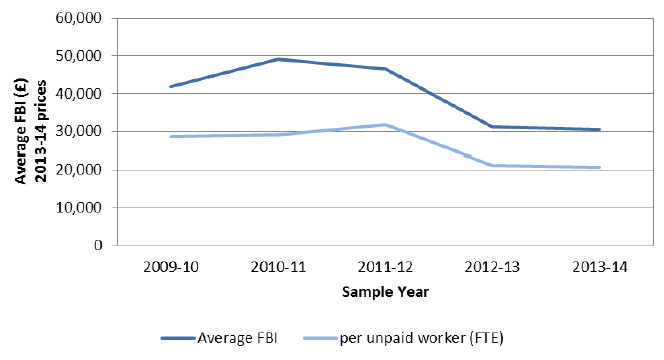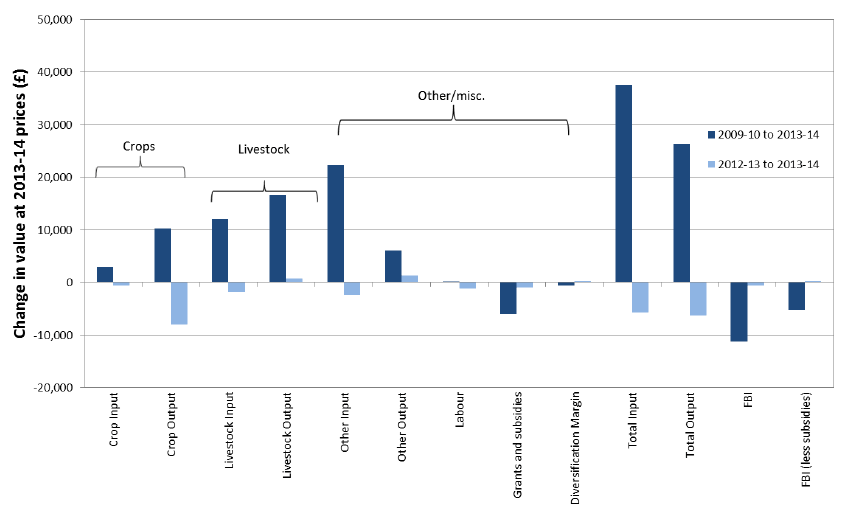Economic Report on Scottish Agriculture 2015
Economic Report on Scottish Agriculture 2015 presenting an overall picture of Scottish agriculture using data from the various agricultural surveys that RESAS manage.
3.2 Farm Business Income (FBI) (Table B2)
Farm Business Income (FBI) is the headline business-level measure of farm income, or profit, providing data for each farm type (TIFF estimates only provide information for the sector as a whole). FBI represents the return to the whole farm business, that is, the total income available to all unpaid labour and their capital invested in the business. Returns from diversified activities (non-agricultural activities that use farm resources, for example: renting out farm cottages for tourism; income from small-medium scale wind turbines; etc.) are included in overall FBI (as they are in TIFF).
In Scotland, the data used to calculate FBI comes from the Farm Accounts Survey (FAS). The FAS represents economically active farms (using at least half the average labour requirement of a crop or livestock enterprise – see SLR definition in section 7.3). The FAS therefore excludes many small holdings. Horticulture, pigs and poultry farms are also excluded, whereas, since TIFF uses national data, it includes all farm types.
Scottish FBI figures for farms classified into types by standard outputs (see section 2.5) are available from 2009-10, up to the latest year available of 2013-14, based on the 2013 crop year. Unless stated otherwise time series are presented in 2013-14 prices, using the GDP (Gross Domestic Product) all items index, adjusted to represent the period covered by each year of the Farm Accounts Survey (FAS). This provides more reliable trends as the effects of inflation are accounted for. The Net Farm Income measure provides a longer time series and is presented by farm type in section 3.12. The difference between FBI and NFI is explained in the FAS methodology and quality note, along with other information on the survey methodology and quality of results, on the agriculture statistics web page[6]. More detailed data tables are also available in the 2013‑14 FAS data tables[7] also on the agriculture statistics web page.
Chart 3.3 below shows that in 2013-14 FBI fell to its lowest level over the last five years, at £31,000. This has remained relatively unchanged from the previous year. Incomes were mixed across all farming sectors which saw general cropping, specialist cattle (LFA) and mixed farm businesses showing a decrease in income and dairy, specialist sheep (LFA), specialist cattle and sheep (LFA), lowland cattle and sheep all showing an increase (on average) (see section 5.3.7 and 5.3.8).
Chart 3.3: Average FBI of Scottish farms, 2009-10 to 2013-14

Incomes were highest in 2010-11, at £49,000, largely due to lower input costs. Along with a rise in output values, fertiliser costs fell after a large increase in the previous year. This allowed the FBI of specialist cereal and general cropping farms to recover from low levels in 2009-10 (see sections 4.2.2 and 4.4).
Chart 3.4: 2013-14 Changes to FBI components: all farm types

Source: online FAS data tables
In 2013-14 the average FBI of Scottish farms was relatively unchanged (fall of £600) at £31,000, compared to 2012-13.
Chart 3.4 shows the average changes to FBI components both in the last year and over the last five years, accounting for inflation. Over the last year, 2012-13 to
2013-14, both crop inputs and outputs have both fallen. Livestock production costs and the value of grants and subsidies also fell, with the output value from livestock rising.
It is the decline in crop output value which has contributed the most to the decline in profitability of Scottish farm businesses in 2013-14. This can possibly be explained by poor weather conditions during the 2012-13 winter which resulted in a reduction in the area of winter crops sown.
While output values have improved over the longer term these have been outweighed by a rise in input costs (in particular “other” costs such as machinery, land and buildings, depreciation, and miscellaneous costs) combined with a declining average value of grants and subsidies. Labour costs are largely unchanged when compared over five years, but have fallen by £1,000 over the last year.
Contact
Email: Agricultural Statistics
There is a problem
Thanks for your feedback